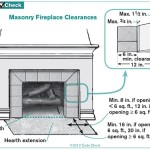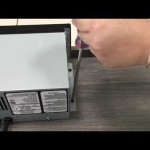Can You Paint The Inside Of A Working Fireplace? An In-Depth Guide
Painting the inside of a fireplace, particularly one that is actively used, presents a unique set of challenges and considerations. The extreme temperatures, soot accumulation, and the potential for the paint to release harmful fumes demand careful planning and execution. Whether painting the firebox, the smoke chamber, or other interior surfaces, understanding the appropriate materials, preparation methods, and safety precautions is crucial for a successful and safe outcome. This article provides a comprehensive guide to painting the inside of a working fireplace, addressing key factors and offering practical advice.
The primary reason homeowners consider painting the interior of a fireplace is usually aesthetic. Over time, the brick or masonry can become stained and discolored by soot and creosote buildup, resulting in an unsightly appearance. A fresh coat of paint can significantly improve the fireplace's visual appeal, making it a more inviting focal point in the room. However, it's essential to prioritize safety and functionality alongside aesthetic improvements.
Before embarking on this project, a thorough inspection of the fireplace's condition is essential. Any existing cracks, crumbling mortar, or other structural issues must be addressed before painting. Failure to do so could lead to further deterioration of the fireplace and potentially hazardous situations.
Key Point 1: Identifying Suitable Paint Types
The most critical aspect of painting the inside of a working fireplace is selecting a heat-resistant paint specifically designed for high-temperature environments. Standard household paints are not suitable because they will blister, peel, and release harmful fumes when exposed to the intense heat of a fire. The two primary types of paint recommended for fireplace interiors are high-temperature paint and refractory paint.
High-Temperature Paint: These paints are formulated to withstand temperatures up to a certain threshold, typically ranging from 1200°F (649°C) to 2000°F (1093°C). They are often available in aerosol cans or as liquid paint that can be applied with a brush or roller. High-temperature paints are generally suitable for surfaces that experience direct flame contact, such as the firebox walls. It is imperative to carefully review the manufacturer's specifications to ensure that the paint's temperature rating meets the demands of the fireplace.
Refractory Paint: Refractory paint, also known as stove paint or firebox paint, is specifically engineered for extreme heat conditions. It provides a durable, heat-resistant coating that can withstand prolonged exposure to high temperatures. Refractory paints are often used in industrial applications, such as furnaces and kilns, and are an excellent choice for fireplaces that are regularly used and exposed to intense heat. These paints often require a curing process, which involves gradually increasing the temperature of the painted surface to ensure proper adhesion and durability. Always adhere to the manufacturer's instructions regarding curing procedures.
It is essential to avoid using paints that contain volatile organic compounds (VOCs), as these chemicals can release harmful fumes when heated. Opt for low-VOC or zero-VOC paints to minimize the risk of indoor air pollution. Consider paints specifically labeled as "fireplace paint," "stove paint," or "high-heat paint," and always read the product information carefully to ensure suitability for fireplace applications.
Key Point 2: Preparing the Fireplace Interior
Proper preparation is crucial for achieving a durable and aesthetically pleasing paint finish. The interior of a working fireplace is typically covered in soot, creosote, and other debris, which must be thoroughly cleaned before painting. Neglecting this step can compromise the paint's adhesion and longevity.
Cleaning: Begin by removing all loose debris, such as ash, loose brick fragments, and any other foreign materials. Use a wire brush or scraper to remove any loose or flaking paint from previous applications. Then, using a stiff brush and a solution of trisodium phosphate (TSP) or a specialized fireplace cleaner, thoroughly scrub the interior surfaces to remove soot and creosote buildup. TSP is a powerful cleaning agent but should be handled with care, wearing gloves and eye protection. Rinse the cleaned surfaces thoroughly with clean water and allow them to dry completely before proceeding.
Repairs: Inspect the fireplace interior for any cracks, gaps, or damaged mortar. Repair any structural issues before painting to prevent further deterioration. Use a high-temperature mortar or refractory cement to fill cracks and repair damaged areas. Allow the mortar to cure completely according to the manufacturer's instructions before painting.
Priming (Optional): In some cases, applying a high-temperature primer may be beneficial. Primer can improve paint adhesion, especially on porous surfaces like brick. Choose a primer specifically designed for high-temperature applications and compatible with the chosen paint. Apply the primer evenly and allow it to dry completely before painting.
Masking: Protect surrounding surfaces, such as the fireplace surround, hearth, and any adjacent walls, with painter's tape and drop cloths. This will prevent paint splatters and ensure a clean, professional finish.
Before painting, ensure the fireplace is completely dry. Any moisture can interfere with the paint's adhesion and lead to premature failure. It is advisable to allow the fireplace to air dry for several days, depending on the humidity levels.
Key Point 3: Application Techniques and Safety Precautions
Applying high-temperature paint to the fireplace interior requires careful technique and adherence to safety precautions. Always work in a well-ventilated area to minimize exposure to fumes. Wear appropriate safety gear, including a respirator mask, gloves, and eye protection.
Application: Follow the manufacturer's instructions regarding paint application. Most high-temperature paints are applied in thin, even coats. Avoid applying thick coats, as this can lead to uneven drying, blistering, and cracking. Use a high-quality paintbrush or roller designed for use with high-temperature paints. If using an aerosol can, hold the can approximately 10-12 inches from the surface and apply the paint in a smooth, even sweeping motion.
Curing: Many high-temperature paints require a curing process to achieve optimal durability and heat resistance. The curing process typically involves gradually increasing the temperature of the painted surface over a period of time. For example, the manufacturer may recommend starting with a low heat for several hours, followed by gradually increasing the heat over subsequent hours. It is crucial to follow the manufacturer's instructions precisely to ensure proper curing. If the paint manufacturer doesn't specify a curing process, starting a small fire and gradually increasing its intensity over a few hours can usually complete the curing process.
Ventilation: Ensure adequate ventilation during the painting and curing process. Open windows and doors to allow fresh air to circulate. Use a fan to help circulate air and remove fumes. Avoid inhaling paint fumes, and take breaks as needed to avoid overexposure.
Safety: Keep flammable materials away from the fireplace during the painting and curing process. Do not smoke or use open flames near the fireplace. Store paint and cleaning solvents in a safe and secure location, away from heat and ignition sources. Consult the paint's Material Safety Data Sheet (MSDS) for specific safety information and handling precautions.
Post-Painting Inspection: After the paint has fully cured, inspect the fireplace interior for any signs of cracking, blistering, or peeling. If any issues are observed, address them promptly to prevent further damage. Touch up any imperfections with additional paint as needed, following the same application and curing procedures.
Alternative to Painting: While painting is a common method for improving the aesthetics of a fireplace interior, consider alternative solutions, such as using a heat-resistant stain or installing a decorative fireplace insert. These options may offer enhanced durability and a more authentic look.
Ultimately, painting the inside of a working fireplace is achievable with proper planning, careful execution, and the use of appropriate materials. Understanding the challenges posed by the high-temperature environment and prioritizing safety are essential for a successful project. While the aesthetic improvement is valuable, ensuring the fireplace's continued safe and efficient operation remains paramount.
Regularly inspecting and maintaining the fireplace, including cleaning and repairing any cracks or damage, will contribute to its longevity and safe operation. Follow these guidelines to help ensure your fireplace remains a safe and aesthetically pleasing focal point in your home.
In addition to the materials already discussed, consider the type of brush you'll be using. A natural bristle brush may not be suitable for some high-temperature paints, as the bristles can degrade or melt under the heat. Instead, opt for a synthetic bristle brush or a foam brush, which are more resistant to high temperatures and solvents. These brushes will also provide a smoother finish.
When selecting a color for your fireplace interior, consider darker shades. Darker colors, such as black or dark gray, tend to hide soot and stains more effectively than lighter colors. This makes them a practical choice for a working fireplace that will inevitably accumulate soot over time. However, personal preference should also be a factor, and lighter colors can be used if desired, provided they are applied correctly and maintained regularly.
Remember that the type of fuel you burn in your fireplace can also affect the longevity of the paint job. Burning seasoned hardwoods will produce less soot and creosote than burning softwoods or improperly dried wood. This can help to extend the life of the paint and reduce the frequency of cleaning.

How To Paint The Inside Of A Fireplace Simple Upgrade Maria Louise Design

How To Paint The Inside Of A Fireplace Sarah Joy

Paint Inside Of Your Fireplace South House Designs

Painting The Interior Of A Fireplace Shine Your Light

How To Paint Inside A Fireplace An Updated Look Painting

How To Spray Paint Fireplace Interior The Diy Playbook

What Kind Of Paint To Use On The Inside A Fireplace Hunker

Can I Paint My Fireplace

Painting The Interior Of A Fireplace Shine Your Light

How To Spray Paint Fireplace Interior The Diy Playbook
Related Posts








